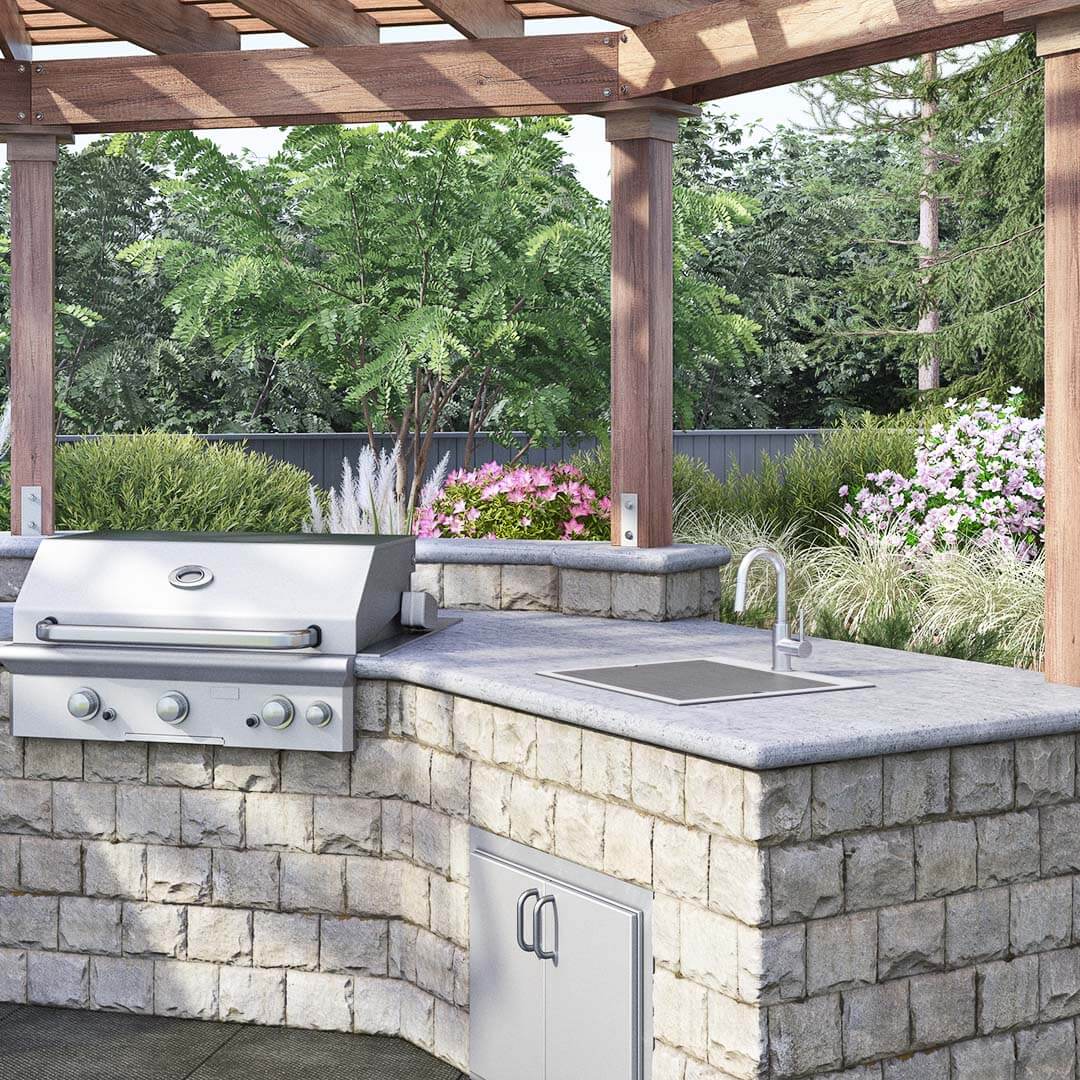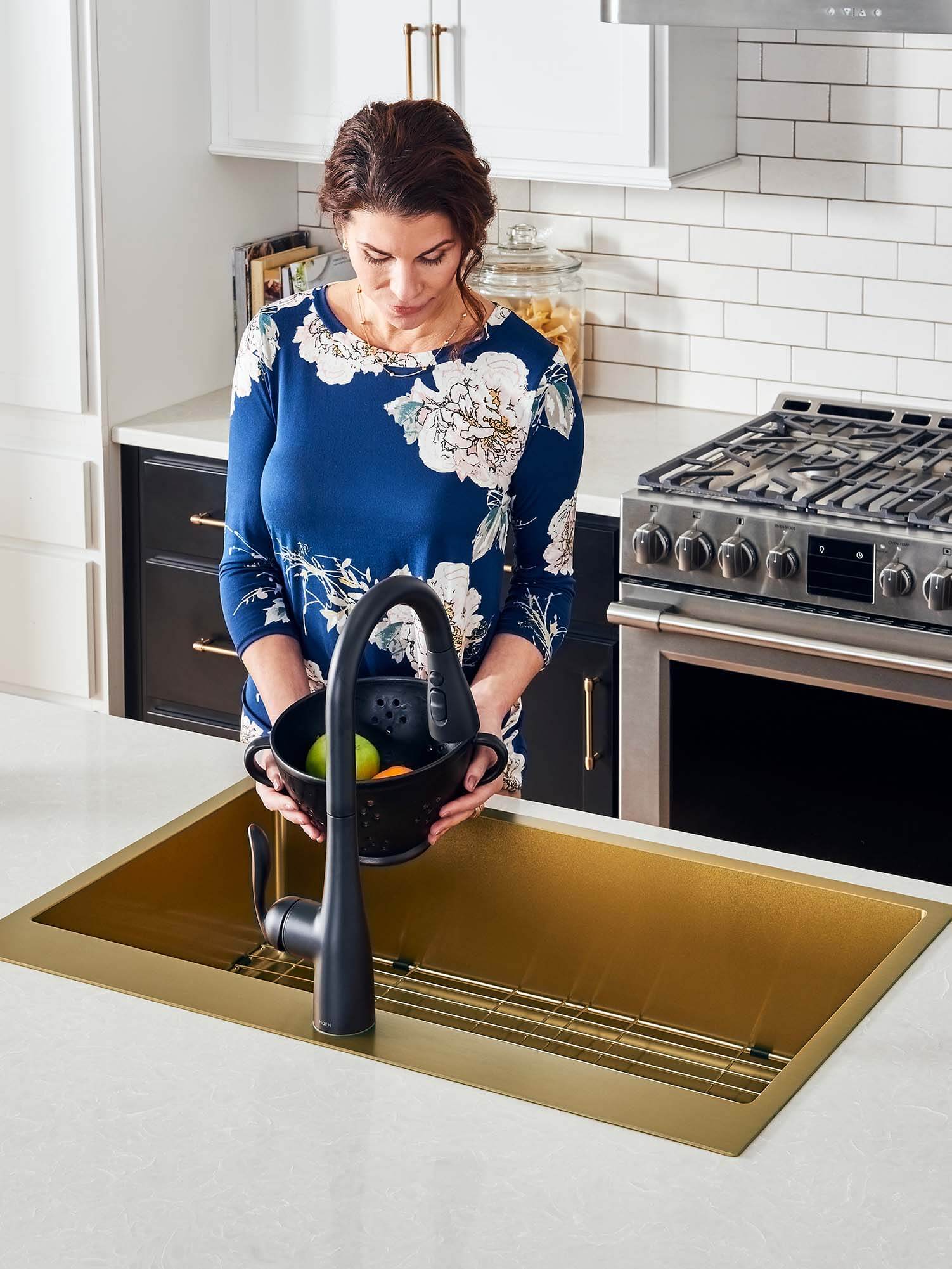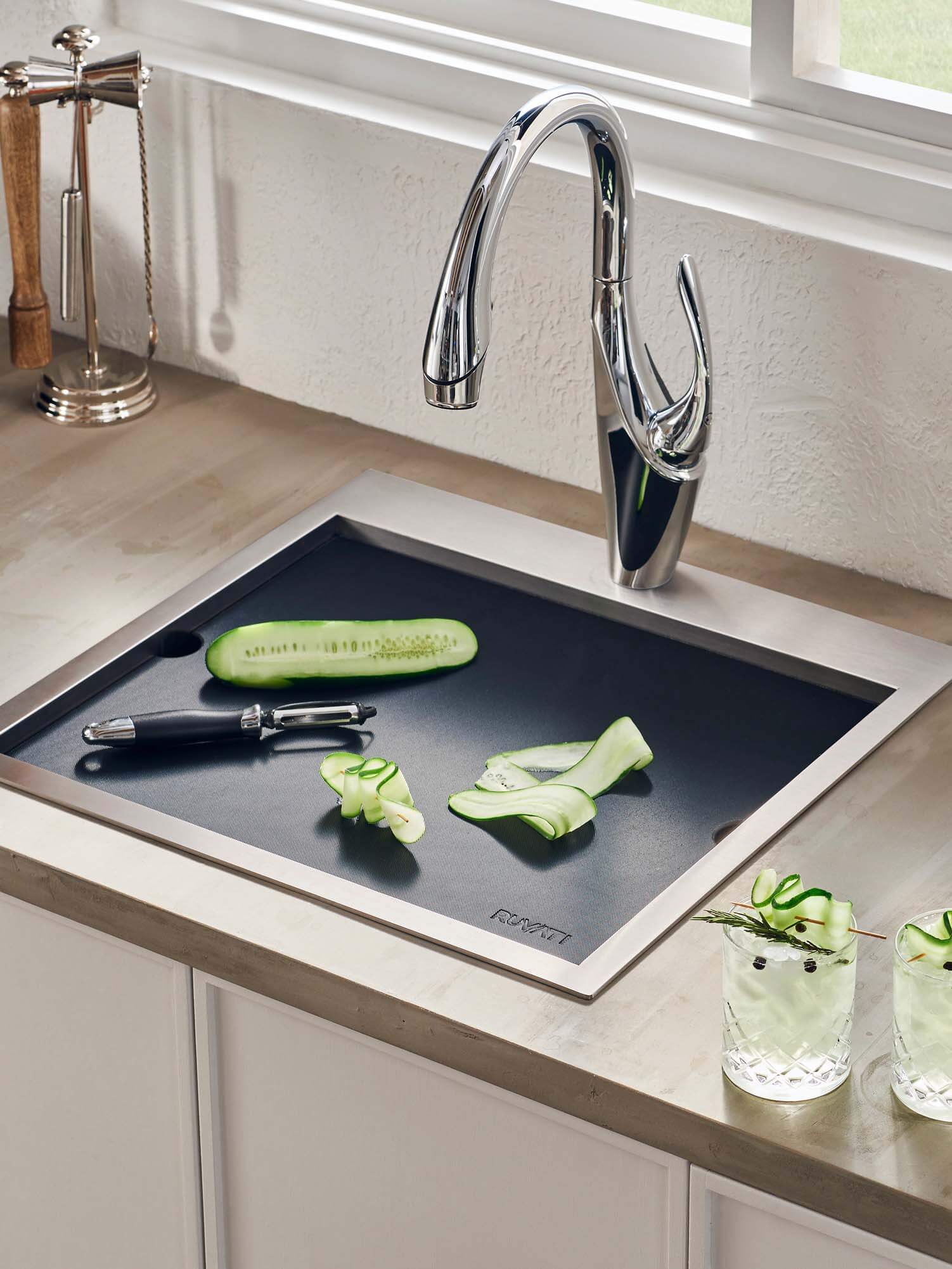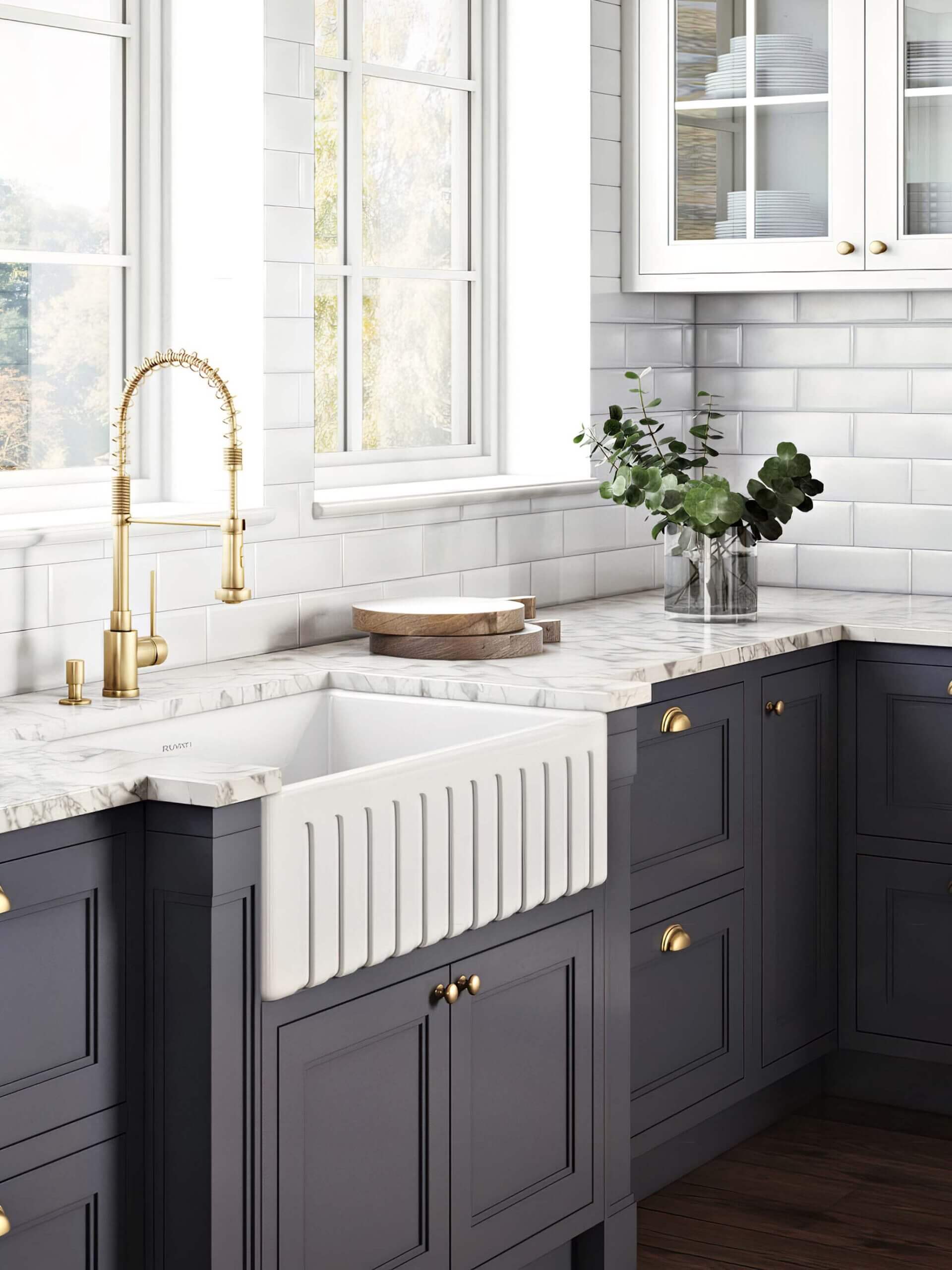In the manufacturing industry, the distinction between 304 and 316 stainless steel might as well be the difference between a green apple and a red apple. You’ve probably heard about their differing corrosion resistances, with 316 often being the choice in more harsh environments, but there’s much more to the story than just chemical composition. You’ll learn about their unique properties, applications, and how they impact the bottom line. Let’s take the plunge into the fascinating world of 304 vs 316 stainless steel.
Key Takeaways
- Both 304 and 316 stainless steel are non magnetic better know as as austenitic grade metals. However, 316’s molybdenum content enhances its resistance to chemicals and marine environments. This makes 316 a perfect candidate for Ruvati’s outdoor sinks
- 316 stainless steel is pricier than 304, largely due to its higher nickel content and the addition of molybdenum.
- 304 stainless steel is widely used in industrial and kitchen applications due to its high corrosion resistant composition and formability.
- While 304 is more cost-effective, 316 stainless steel is resistant to corrosion, superior strength, and is better suited for applications with exposure to chlorides.
Understanding 304 SS
Understanding 304 stainless steel, or grade T-304, involves recognizing its versatile properties and wide-ranging applications. Composed primarily of 18 percent chromium and 8 percent nickel, 304 stainless steel offers excellent corrosion resistance in various environments, making it suitable for sinks, saucepans, and architectural paneling. Its low carbon variant, 304L, enhances weldability and is preferred for heavy gauge components. Additionally, 304H, with its higher carbon content, is employed in high-temperature settings. Fabricating 304 stainless steel requires dedicated tools and precautions to avoid contamination. While heat treatment cannot harden it, it exhibits good machinability and weldability, making it indispensable in industries like food production, pharmaceuticals, and architecture.
304 vs 304L
To truly appreciate the versatility of 304 stainless steel, you must understand its variant – the 304L grade, which possesses certain unique properties that make it a preferred choice for certain applications. While 304 stainless steel offers exceptional mechanical properties and corrosion resistance, 304L stainless steel is specifically designed to provide robust performance in welding applications due to its lower carbon content.
Property | T 304 SS | T 304L SS |
|---|---|---|
| Carbon Content | Higher | Lower |
| Weldability | Good | Excellent |
| Mechanical Properties | Superior | Slightly lower |
| Corrosion Resistance | Good | Better |
| Applications | Broad | Specific for Welding |
Hence, in applications requiring significant welding, you’ll find 304L stainless steel to be more appropriate. As always, the choice between 304 and 304L stainless steel hinges on your specific application requirements. For all Ruvati indoor stainless steel sinks, whether it be for the kitchen, bathroom, or laundry room, we use T-304 stainless steel. This ensures durability, hassle-free cleaning, and a resolutely modern look. Each Ruvati stainless steel sink features a luxurious satin finish that not only adds to the sink’s beauty, but also provides a great way to hide any water stains, finger prints or small scratches that may occur.
Application of 304 SS
Let’s dive into the wide-ranging applications of 304 stainless steel, a versatile material known for its excellent corrosion resistance and heat tolerance. This omnipresent steel finds its way into various industries, meeting diverse requirements through its unique attributes.
- Corrosion Resistance: The applications of 304 SS largely exploit its corrosion resistance. Used in a host of environments, from your kitchen sinks and cutlery to automobile trim and aircraft parts, its ability to resist rusting and other forms of corrosion makes it a popular choice.
- Heat Resistance: 304 SS also excels in heat resistance. This property makes it apt for high-temperature manufacturing processes, and you’ll find it employed in heat exchangers, boilers, and valves.
- Fabrication Friendly: Thanks to its easy workability, 304 SS is often chosen for projects demanding complex shaping and forming. It’s a go-to for architectural features, construction materials, and welded frames.
- Manufacturing Processes: The manufacturing processes of 304 SS are varied due to its versatility. Whether it’s hot or cold working, machining, or welding, the adaptability of 304 SS makes it a preferred material.
Whether you’re an innovator in the industry or a curious observer, understanding the applications of 304 SS offers insight into why it’s such a widely used material.

Understanding 316 SS
Now, let’s shift your focus to Type 316 stainless steel, often referred to as T-316. This particular type is renowned for its superior resistance against corrosion, especially in high-saline environments, thanks to its molybdenum composition. You’ll gain insights into its unique characteristics, including its variant 316L, which offers similar properties with a lower carbon content.
316 vs 316L
Diving deeper into the world of stainless steel, you’ll find that 316, stands out with its distinctive properties and uses. This type of austenitic stainless steel is similar to 316L stainless steel, but has a significant advantage.
- Lower Carbon Content: 316L has a lower carbon content than 316, enhancing its corrosion resistance.
- Molybdenum: Molybdenum makes it particularly resistant to pitting and crevice corrosion in chloride environments.
- Material Selection: 316L is often chosen for marine applications, chemical processing, and pharmaceutical use due to its advanced resistance properties.
- Versatility: It’s also used in industrial applications where welding is required, thanks to its lower carbon content.
The Merino collection from Ruvati features marine-grade T-316 stainless steel designed for environments where extreme corrosion resistance is important – like boat decks or outdoor grill areas. This is the highest grade stainless steel available from Ruvati and is optimal for exposure to outdoor environments. In all kinds of weather, Ruvati outdoor sinks are prepared to endure whatever may occur.
Property | T 316 SS | T 316L SS |
|---|---|---|
| Carbon Content | Higher | Lower |
| Weldability | Good | Excellent |
| Mechanical Properties | Superior | Slightly lower |
| Corrosion Resistance | Excellent | Superior |
| Applications | Broad | Specific for welding |
Application of 316 SS
In the realm of industrial applications, Stainless Steel 316 stands out for its superior resistance to corrosion and pitting, making it a popular choice for an array of challenging environments. This corrosion resistance is mainly attributed to its unique alloying elements, including carbon, chromium, nickel, molybdenum, and manganese.
The various grades of Stainless Steel 316, such as 316L, 316H, and stabilized 316Ti, each offer tailored properties for specific applications. The 316L grade, for instance, is a low-carbon version that is ideal for welding scenarios due to its superior weldability. On the other hand, 316H and 316Ti grades are enhanced for high-temperature applications.
Producers of Stainless Steel 316 understand these distinct properties and manufacture a range of products suitable for different sectors. From the chemical industry to marine applications, the versatility of 316 SS is seen globally.
To sum it up, the applications of 316 SS are broad and diverse, thanks to its enhanced corrosion resistance and adaptability offered by its various grades. As innovation continues, expect to see Stainless Steel 316 remain a fixture in demanding environments.

Key Differences Between 304 and 316 Stainless Steel
At Ruvati, we pride ourselves on only selling the highest quality stainless steel. As something you use everyday, your sink should stand the test of time. Not only is every Ruvati sink made with a 16 gauge stainless steel, they are designed to fit their environment. Unique to Ruvati outdoor sinks, we use T-316 stainless steel for even further protection. To understand the difference between T-304 and T-316, we have outlined their identifying traits.
Chemical Composition
When it comes to the chemical composition of 304 and 316 stainless steel, there are some key differences you’ll want to be aware of.
- Both 304 and 316 stainless steels are high in chromium and nickel which enhance their corrosion resistance. However, the proportions differ, affecting their mechanical properties.
- 304 stainless steel is an 18/8 steel, meaning it contains 18% chromium and 8% nickel.
- 316 stainless steel has slightly less chromium, but contains 10% nickel. It also has 2% molybdenum, which is not found in 304.
- This additional molybdenum gives 316 superior corrosion resistance in many environments.
Understanding these differences in chemical composition can help you make an informed decision when selecting the right stainless steel for your needs.
Corrosion Resistance
Building on the differences in their chemical compositions, let’s now examine how these variations between 304 and 316 stainless steel contribute to their respective corrosion resistance abilities. As chromium-nickel stainless steel types, both 304 and 316 offer decent corrosion resistance. However, the presence of molybdenum in 316 gives it superior corrosion resistance, particularly against chloride pitting. This makes it ideal for use in marine environments or chemical processing where contact with corrosive substances is high. On the other hand, 304, though it fair well in many applications, might not hold up as well under such severe conditions. Hence, understanding these key differences in corrosion resistance can guide you towards the best choice for your specific applications.
Cost Comparison
In evaluating the cost differences between 304 and 316 stainless steel, it’s essential to consider that 316 generally carries a price tag approximately 40% higher due to its increased nickel content and the addition of molybdenum.
However, when deciding which type to invest in, you must factor in more than just the initial cost. Consider these four key points: 1. The price difference can be justified by the enhanced durability and corrosion resistance of 316, particularly in harsh environments. 2. If your project has specific requirements for nickel content or the addition of molybdenum, 316 might be your best bet. 3. Review your budget constraints to ensure the higher cost of 316 can be accommodated. 4. Keep in mind that the long-term maintenance costs may be lower with 316 due to its superior quality.
Mechanical Properties
You’ll notice key differences in the mechanical properties between 304 and 316 stainless steel, which significantly influence their suitability for various applications. The 316 grade has a higher tensile strength and hardness, while the 304 grade is more flexible due to its lower modulus of elasticity.
| SS Type | T-304 | T-316 |
|---|---|---|
| Tensile Strength | Moderate | High |
| Hardness | Moderate | High |
| Modulus of Elasticity | High | Lower |
| Physical Properties | Excellent | Superior |
Understanding these mechanical properties is crucial when deciding which grade to use in manufacturing. If you need more strength and hardness, 316 is your go-to. However, if flexibility is key, then 304 might be more suitable. Always remember, the success of your innovation hinges on the right choice of materials.
What to Consider When Choosing Between 304 and 316
Navigating the decision between 304 and 316 stainless steel can be a complex task, as it involves considering various factors such as cost, corrosion resistance needs, and the specific requirements of your application. Both 304 and 316 offer robust features, but they are suited for different usage scenarios.
- Cost: 316 is typically more expensive than 304 due to its higher nickel content and the presence of molybdenum. Understand your budget and evaluate if the increased cost of 316 provides a significant advantage for your specific needs.
- Corrosion Resistance: If your application involves exposure to corrosive elements or high temperatures, 316’s superior corrosion resistance and strength could prove beneficial.
- Usage: 304 is commonly used in kitchen equipment and industrial applications, offering good corrosion resistance. Conversely, 316, with its enhanced properties, is ideal for applications like marine equipment and chemical processing.
- Long-term Savings: Though 316 may involve a higher initial investment, its superior durability can lead to long-term savings, especially in harsh operating conditions.
Key Differences Between 304 and 316 Stainless Steel
At Ruvati, we pride ourselves on only selling the highest quality stainless steel. As something you use everyday, your sink should stand the test of time. Not only is every Ruvati sink made with a 16 gauge stainless steel, they are designed to fit their environment. Unique to Ruvati outdoor sinks, we use T-316 stainless steel for even further protection. To understand the difference between T-304 and T-316, we have outlined their identifying traits.
Chemical Composition
When it comes to the chemical composition of 304 and 316 stainless steel, there are some key differences you’ll want to be aware of.
- Both 304 and 316 stainless steels are high in chromium and nickel which enhance their corrosion resistance. However, the proportions differ, affecting their mechanical properties.
- 304 stainless steel is an 18/8 steel, meaning it contains 18% chromium and 8% nickel.
- 316 stainless steel has slightly less chromium, but contains 10% nickel. It also has 2% molybdenum, which is not found in 304.
- This additional molybdenum gives 316 superior corrosion resistance in many environments.
Understanding these differences in chemical composition can help you make an informed decision when selecting the right stainless steel for your needs.
Corrosion Resistance
Building on the differences in their chemical compositions, let’s now examine how these variations between 304 and 316 stainless steel contribute to their respective corrosion resistance abilities. As chromium-nickel stainless steel types, both 304 and 316 offer decent corrosion resistance. However, the presence of molybdenum in 316 gives it superior corrosion resistance, particularly against chloride pitting. This makes it ideal for use in marine environments or chemical processing where contact with corrosive substances is high. On the other hand, 304, though it fair well in many applications, might not hold up as well under such severe conditions. Hence, understanding these key differences in corrosion resistance can guide you towards the best choice for your specific applications.
Cost Comparison
In evaluating the cost differences between 304 and 316 stainless steel, it’s essential to consider that 316 generally carries a price tag approximately 40% higher due to its increased nickel content and the addition of molybdenum.
However, when deciding which type to invest in, you must factor in more than just the initial cost. Consider these four key points: 1. The price difference can be justified by the enhanced durability and corrosion resistance of 316, particularly in harsh environments. 2. If your project has specific requirements for nickel content or the addition of molybdenum, 316 might be your best bet. 3. Review your budget constraints to ensure the higher cost of 316 can be accommodated. 4. Keep in mind that the long-term maintenance costs may be lower with 316 due to its superior quality.
Mechanical Properties
You’ll notice key differences in the mechanical properties between 304 and 316 stainless steel, which significantly influence their suitability for various applications. The 316 grade has a higher tensile strength and hardness, while the 304 grade is more flexible due to its lower modulus of elasticity.
| SS Type | T-304 | T-316 |
|---|---|---|
| Tensile Strength | Moderate | High |
| Hardness | Moderate | High |
| Modulus of Elasticity | High | Lower |
| Physical Properties | Excellent | Superior |
Understanding these mechanical properties is crucial when deciding which grade to use in manufacturing. If you need more strength and hardness, 316 is your go-to. However, if flexibility is key, then 304 might be more suitable. Always remember, the success of your innovation hinges on the right choice of materials.
What to Consider When Choosing Between 304 and 316
Navigating the decision between 304 and 316 stainless steel can be a complex task, as it involves considering various factors such as cost, corrosion resistance needs, and the specific requirements of your application. Both 304 and 316 offer robust features, but they are suited for different usage scenarios.
- Cost: 316 is typically more expensive than 304 due to its higher nickel content and the presence of molybdenum. Understand your budget and evaluate if the increased cost of 316 provides a significant advantage for your specific needs.
- Corrosion Resistance: If your application involves exposure to corrosive elements or high temperatures, 316’s superior corrosion resistance and strength could prove beneficial.
- Usage: 304 is commonly used in kitchen equipment and industrial applications, offering good corrosion resistance. Conversely, 316, with its enhanced properties, is ideal for applications like marine equipment and chemical processing.
- Long-term Savings: Though 316 may involve a higher initial investment, its superior durability can lead to long-term savings, especially in harsh operating conditions.
Case Study: Real-world Applications and Selection Criteria
While considering the cost and corrosion resistance is crucial, let’s explore some real-world applications and selection criteria through a practical case study better to understand the choice between 304 and 316 stainless steel.
In the aerospace industry, both 304 and 316 austenitic stainless steel are used due to their strength and corrosion resistance. For medical equipment, their hygienic properties make them a favoured choice. Their durability and aesthetic appeal also make them common in household equipment.
But how do you choose between the two? Consider factors like corrosion resistance, cost, and specific application requirements. For instance, in the food and drink industry, 316 stainless steel is often preferred due to its superior corrosion resistance.
Let’s illustrate this with a brief table:
Stainless Steel Grade | Application |
|---|---|
| 304 | – Kitchen equipment – Architectural panelling – Chemical containers – Automotive and aerospace structural use – Food processing equipment (304L variant for welded structures) |
| 316 | – Marine environments, boat fittings – Chemical processing equipment – Heat exchangers – Pharmaceutical and medical applications – Architectural applications in highly corrosive environments – Food processing and water treatment equipment (316L variant for welded structures with reduced carbide precipitation) |
The selection criteria should revolve around the specific requirements of the application, your budget constraints, and the desired level of corrosion resistance. Remember, investing in the right type of stainless steel can lead to long-term benefits and performance efficiencies.
Future Trends in Stainless Steel Use in Manufacturing
Peering into the future of stainless steel use in manufacturing reveals an evolving landscape impacted by the aftermath of the COVID-19 pandemic, shifting technological trends, and fluctuating market dynamics. These changes are gradually shaping the future of stainless steel products, with a keen focus on innovation and sustainable practices.
Here’s a snapshot of what’s on the horizon:
- Recovery Post-COVID-19: The pandemic led to a slowdown in construction and other industries that significantly use stainless steel. However, you’ll witness a market rebound as countries stabilize and industries recover.
- Technological Innovations: You’ll be part of a shift towards sustainable stainless steel manufacturing. The drive to reduce CO2 emissions is pushing technological advancements, transforming how stainless steel products are made.
- Growing Demand in Automotive: The automotive industry’s rapid growth is set to boost stainless steel use. You’ll see more seatbelt springs, hose clamps, and other components made of this durable material.
- Challenges from Substitutes: While stainless steel holds many advantages, the availability of substitutes like aluminum and carbon steel could impact its market dominance.
Navigating these future trends in stainless steel manufacturing requires a proactive approach, adaptability, and an eagerness for innovation. To wrap things up, it’s clear that both 304 and 316 stainless steels bring unique attributes to the table, and your choice between them should hinge on your specific application needs, budget, and environmental conditions. Both stainless steel grades have their strengths, with 316 offering superior corrosion resistance due to its chemical composition, while 304 provides a cost-effective solution with adequate mechanical properties.
Here’s a chart to remember the differences between 304 and 316:
Feature/Use | 304 Stainless Steel | 316 Stainless Steel |
|---|---|---|
| Chemical Composition | – 18-20% chromium – 8-10.5% nickel – ≤0.08% carbon – Other elements: manganese, phosphorus, sulfur, silicon, iron | – 16-18% chromium – 10-14% nickel – 2-3% molybdenum – ≤0.08% carbon (316) – ≤0.03% carbon (316L) – Other elements: manganese, phosphorus, sulfur, silicon, iron |
| Corrosion Resistance | Excellent resistance to a wide variety of environments, particularly oxidation; not as effective in chloride-rich environments which can lead to pitting | Superior corrosion resistance due to molybdenum content, especially in chloride environments which can cause pitting and crevice corrosion; suitable for more challenging conditions like marine and industrial atmospheres |
| Heat Resistance | Good oxidation resistance up to 870°C for intermittent service and up to 925°C for continuous service | Good oxidation resistance in intermittent use below 871°C and continuous use up to 927°C in air; better carbide precipitation resistance in 316L variant |
| Applications | – Kitchen equipment – Architectural panelling – Chemical containers – Automotive and aerospace structural use – Food processing equipment (304L variant for welded structures) | – Marine environments, boat fittings – Chemical processing equipment – Heat exchangers – Pharmaceutical and medical applications – Architectural applications in highly corrosive environments – Food processing and water treatment equipment (316L variant for welded structures with reduced carbide precipitation) |
| Weldability and Formability | Excellent, suitable for a wide range of forming and welding processes; 304L variant is preferred for welding to minimize carbide precipitation | Very good, similar to 304 but with the added advantage of reduced carbide precipitation risk in welding due to lower carbon content in 316L; ensures better corrosion resistance post-welding |
| Mechanical Properties | – Ultimate Tensile Strength: 515 MPa – Yield Strength: 205 MPa – Modulus of Elasticity: 193-200 GPa | – Ultimate Tensile Strength: 515 MPa (annealed), up to 620 MPa (cold finished) – Yield Strength: 205 MPa (annealed), up to 310 MPa (cold finished) – Modulus of Elasticity: 193 GPa |
| Unique Features | – Balanced austenitic structure makes it non-magnetic and highly ductile – Variants like 304L have lower carbon content to increase ductility and welding performance | – Addition of molybdenum enhances corrosion resistance – 316L variant has lower carbon content, significantly reducing the risk of carbide precipitation during welding and enhancing corrosion resistance |










